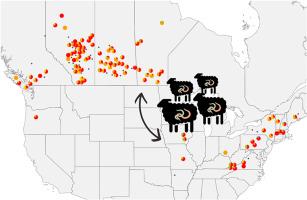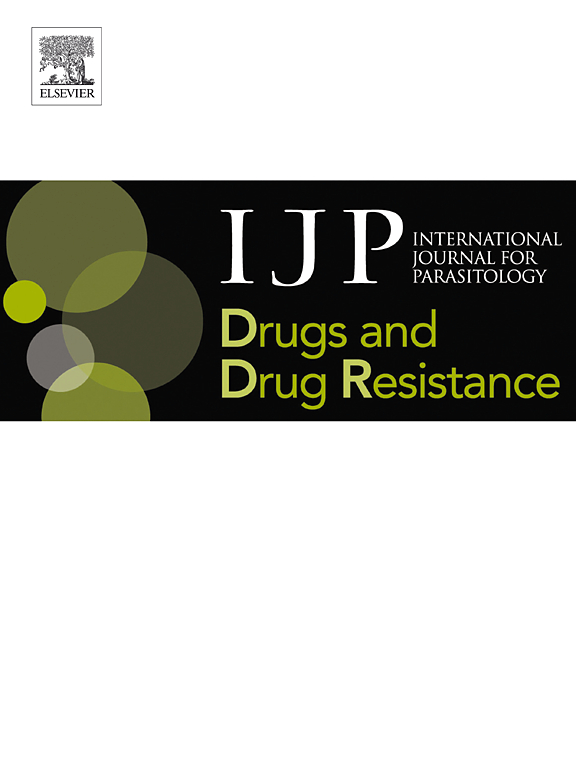Similar patterns of benzimidazole resistance alleles in ovine gastrointestinal nematodes from Western Canada and Eastern United States supports their shared origins and subsequent spread
IF 3.4
2区 医学
Q1 PARASITOLOGY
International Journal for Parasitology: Drugs and Drug Resistance
Pub Date : 2025-10-07
DOI:10.1016/j.ijpddr.2025.100620
引用次数: 0
Abstract
Livestock movement facilitates translocation of anthelmintic resistant parasites, but the extent to which resistance emergence depends on animal movement is still poorly understood. Benzimidazole resistance is widespread in ovine trichostrongylid nematodes, and our understanding of its molecular basis now allows for molecular epidemiology investigations. This study applies deep amplicon sequencing of the isotype-1 β-tubulin locus to compare the prevalence and frequency of benzimidazole resistance Single Nucleotide Polymorphisms (SNPs), and their alleles, for trichostrongylid populations from 102 Western Canadian and 28 Eastern USA sheep flocks. For H. contortus, benzimidazole resistance SNPs were at fixation tin almost all flocks from both regions; that is, present at, or close to, 100 % frequency. For T. circumcincta and T. colubriformis, although at fixation in most Eastern USA flocks, resistance SNPs they were at a much lower prevalence in Western Canada, consistent with the lower anthelmintic use and selection pressure. The benzimidazole resistance SNP profiles were identical across these regions: F200Y (TTC > TAC) predominated for all three species in both regions, but there were differences between the species at codons 167 and 198. For H. contortus, F167Y (TTC > TAC) was at moderate prevalence but no codon 198 resistance SNPs occurred in either region. For T. circumcincta, E198A (GAA > GCA) was at low prevalence and for T. colubriformis, F200Y (TTC > TAC) was the only resistance SNP detected in both regions. Analysis of diversity and distribution of Amplicon Sequence Variants (ASVs) carrying resistance SNPs revealed that, in all three species, the same major resistance alleles were present in both regions at very similar relative frequencies. These results are consistent with a model of benzimidazole resistant ovine gastrointestinal nematodes (GIN) spreading across North America from common origins facilitated by animal movement. This model emphasizes the importance of biosecurity in limiting the emergence and spread of anthelmintic resistance in ruminant GIN. Keywords: molecular epidemiology, deep amplicon sequencing, anthelmintic resistance, nemabiome, benzimidazoles.

在加拿大西部和美国东部的绵羊胃肠道线虫中,苯并咪唑抗性等位基因的相似模式支持它们的共同起源和随后的传播
牲畜的流动促进了抗虫寄生虫的易位,但耐药性的出现在多大程度上取决于动物的流动仍然知之甚少。苯并咪唑耐药性在羊毛线虫中广泛存在,我们对其分子基础的了解现在允许进行分子流行病学调查。本研究对来自102个加拿大西部和28个美国东部绵羊群体的单核苷酸多态性(snp)及其等位基因进行了深扩增子测序,比较了其对苯并咪唑抗性的患病率和频率。对弯纹夜蛾,两区几乎所有禽群的固定物中均存在苯并咪唑抗性snp;也就是说,以或接近100%的频率出现。对于环皮绦虫和绿形绦虫,尽管在大多数美国东部禽群中固定,但抗性snp在加拿大西部的流行率要低得多,这与较低的驱虫使用和选择压力相一致。在这两个区域中,3个物种对苯并咪唑的抗性SNP谱是相同的:F200Y (TTC >; TAC)在两个区域均占优势,但在密码子167和198处存在差异。在弯毛鼠中,F167Y (TTC >; TAC)的流行率中等,但两个地区均未出现密码子198抗性snp。在环皮绦虫中,E198A (GAA >; GCA)的流行率较低,而在色形绦虫中,F200Y (TTC >; TAC)是两个地区唯一检测到的耐药SNP。对携带抗性snp的扩增子序列变异(Amplicon Sequence variant, asv)的多样性和分布分析表明,在所有3个物种中,两个区域均存在相同的主要抗性等位基因,且相对频率非常相似。这些结果与抗苯并咪唑羊胃肠道线虫(GIN)通过动物运动从共同起源传播到北美的模型一致。该模型强调了生物安全在限制反刍金猴抗虫性出现和传播方面的重要性。关键词:分子流行病学,深度扩增子测序,驱虫耐药,奈马比组,苯并咪唑。
本文章由计算机程序翻译,如有差异,请以英文原文为准。
求助全文
约1分钟内获得全文
求助全文
来源期刊

International Journal for Parasitology: Drugs and Drug Resistance
PARASITOLOGY-PHARMACOLOGY & PHARMACY
CiteScore
7.90
自引率
7.50%
发文量
31
审稿时长
48 days
期刊介绍:
The International Journal for Parasitology – Drugs and Drug Resistance is one of a series of specialist, open access journals launched by the International Journal for Parasitology. It publishes the results of original research in the area of anti-parasite drug identification, development and evaluation, and parasite drug resistance. The journal also covers research into natural products as anti-parasitic agents, and bioactive parasite products. Studies can be aimed at unicellular or multicellular parasites of human or veterinary importance.
 求助内容:
求助内容: 应助结果提醒方式:
应助结果提醒方式:


